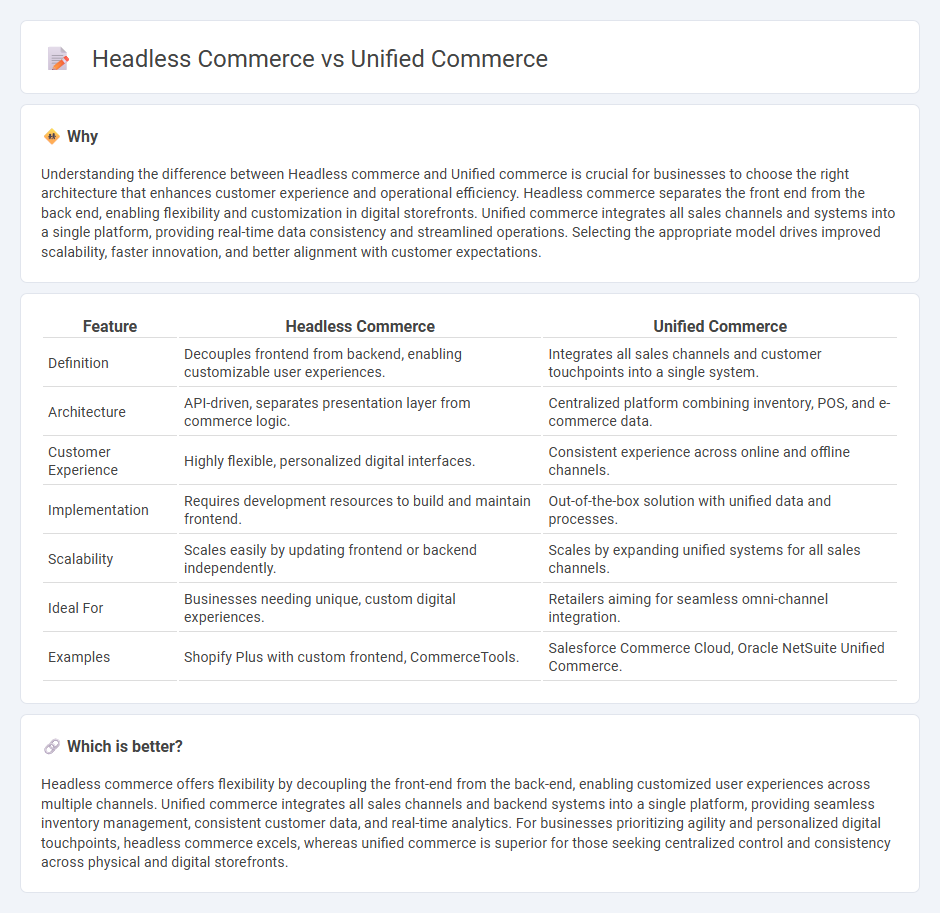
Headless commerce separates the frontend presentation layer from the backend eCommerce functionality, allowing businesses to deliver personalized customer experiences across multiple channels with greater flexibility. Unified commerce integrates all sales channels and customer engagement points into a single system, providing consistent data and seamless operations across online, offline, and mobile platforms. Explore the key differences and benefits of headless and unified commerce to determine which approach suits your business needs.
Why it is important
Understanding the difference between Headless commerce and Unified commerce is crucial for businesses to choose the right architecture that enhances customer experience and operational efficiency. Headless commerce separates the front end from the back end, enabling flexibility and customization in digital storefronts. Unified commerce integrates all sales channels and systems into a single platform, providing real-time data consistency and streamlined operations. Selecting the appropriate model drives improved scalability, faster innovation, and better alignment with customer expectations.
Comparison Table
| Feature | Headless Commerce | Unified Commerce |
|---|---|---|
| Definition | Decouples frontend from backend, enabling customizable user experiences. | Integrates all sales channels and customer touchpoints into a single system. |
| Architecture | API-driven, separates presentation layer from commerce logic. | Centralized platform combining inventory, POS, and e-commerce data. |
| Customer Experience | Highly flexible, personalized digital interfaces. | Consistent experience across online and offline channels. |
| Implementation | Requires development resources to build and maintain frontend. | Out-of-the-box solution with unified data and processes. |
| Scalability | Scales easily by updating frontend or backend independently. | Scales by expanding unified systems for all sales channels. |
| Ideal For | Businesses needing unique, custom digital experiences. | Retailers aiming for seamless omni-channel integration. |
| Examples | Shopify Plus with custom frontend, CommerceTools. | Salesforce Commerce Cloud, Oracle NetSuite Unified Commerce. |
Which is better?
Headless commerce offers flexibility by decoupling the front-end from the back-end, enabling customized user experiences across multiple channels. Unified commerce integrates all sales channels and backend systems into a single platform, providing seamless inventory management, consistent customer data, and real-time analytics. For businesses prioritizing agility and personalized digital touchpoints, headless commerce excels, whereas unified commerce is superior for those seeking centralized control and consistency across physical and digital storefronts.
Connection
Headless commerce enables flexible front-end customization by decoupling the presentation layer from backend e-commerce functionalities, allowing seamless integration across multiple platforms. Unified commerce consolidates all sales channels and customer touchpoints into a single system to deliver a consistent shopping experience. Headless commerce supports unified commerce by providing the technical foundation for real-time data synchronization and omnichannel customer engagement.
Key Terms
Integration
Unified commerce integrates all sales channels, customer data, and backend systems into a single platform to ensure seamless operations and consistent customer experiences. Headless commerce separates the frontend from the backend, allowing for flexible integration of multiple interfaces and third-party services via APIs, enhancing customization and scalability. Explore the key differences in integration approaches to determine the best fit for your business needs.
Flexibility
Unified commerce integrates all sales channels and customer data into a single platform, offering seamless experiences and streamlined operations. Headless commerce decouples the front-end presentation layer from the back-end commerce engine, providing maximum flexibility in customizing user interfaces across multiple touchpoints. Explore the advantages and use cases of both approaches to determine the best flexibility solution for your business needs.
Customer Experience
Unified commerce integrates all sales channels into a single platform, providing a seamless and personalized customer experience by synchronizing inventory, customer data, and purchase history in real-time. Headless commerce uses a decoupled frontend and backend architecture, allowing businesses to deliver highly customized and flexible customer interfaces across various touchpoints, enhancing engagement and responsiveness. Explore how adopting unified or headless commerce can elevate your customer experience strategy and drive loyalty.
Source and External Links
Unified Commerce: The Future of Seamless Shopping (2024) - Shopify - Unified commerce is a fully integrated retail system that enables merchants to manage sales channels, inventory, orders, and marketing from a single platform, providing customers with seamless, personalized shopping experiences across all touchpoints.
What Is Unified Commerce--And Why Is It Essential in 2025 and ... - Unified commerce is a centralized platform that unifies backend commerce solutions to deliver a single source of transactional truth, allowing businesses to track customers in real time, streamline operations, and offer consistent, personalized experiences across all channels.
What is Unified Commerce? Definition + Tips - Salesforce - Unified commerce combines all sales channels such as online, in-store, and mobile, creating operational efficiency and a smooth customer experience by connecting data, inventory, and transactions instantly across every channel.
 dowidth.com
dowidth.com